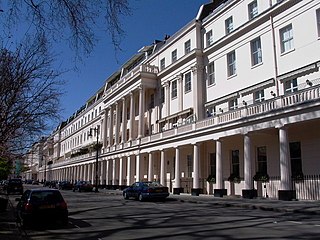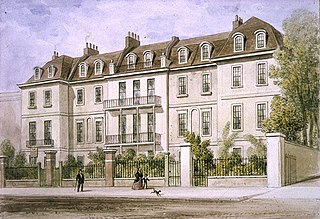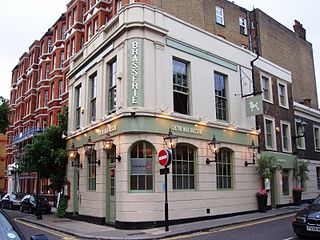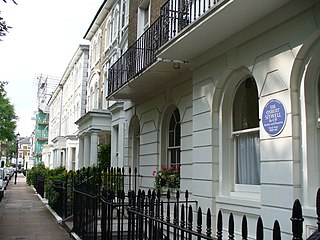
The Royal Borough of Kensington and Chelsea is an Inner London borough with royal status. It is the smallest borough in London and the second smallest district in England; it is one of the most densely populated administrative regions in the United Kingdom. It includes affluent areas such as Notting Hill, Kensington, South Kensington, Chelsea, and Knightsbridge.

Carlyle's House, in Chelsea, central London, was the home of Thomas and Jane Welsh Carlyle from 1834 until their deaths. The house was purchased by public subscription and placed in the care of the Carlyle's House Memorial Trust in 1895. They opened the house to the public and maintained it until 1936, when control of the property was assumed by the National Trust, inspired by co-founder Octavia Hill's earlier pledge of support for the house. It became a Grade II listed building in 1954.

Eaton Square is a rectangular, residential garden square in London's Belgravia district. It is the largest square in London. It is one of the three squares built by the landowning Grosvenor family when they developed the main part of Belgravia in the 19th century that are named after places in Cheshire — in this case Eaton Hall, the Grosvenor country house. It is larger but less grand than the central feature of the district, Belgrave Square, and both larger and grander than Chester Square. The first block was laid out by Thomas Cubitt from 1827. In 2016 it was named as the "Most Expensive Place to Buy Property in Britain", with a full terraced house costing on average £17 million — many of such town houses have been converted, within the same, protected structures, into upmarket apartments.

Chelsea Old Church, also known as All Saints, is an Anglican church, on Old Church Street, Chelsea, London SW3, England, near Albert Bridge. It is the church for a parish in the Diocese of London, part of the Church of England. Inside the Grade I listed building, there is seating for 400 people. There is a memorial plaque to the author Henry James (1843–1916) who lived nearby on Cheyne Walk. To the west of the church is a small public garden containing a sculpture by Sir Jacob Epstein.

Ettington is a village and civil parish about 5.5 miles (9 km) south-east of Stratford-upon-Avon in Warwickshire, England. The 2011 Census recorded the parish's population as 1,171. The present village is on the A422 main road linking Stratford and Banbury. The A429 main road linking Warwick and Cirencester used to run through the village, and now uses a bypass just west of it. The Fosse Way Roman road crosses the A422 0.6 miles (1 km) east of the village.

Lindsey House is a Grade II* listed villa in Cheyne Walk, Chelsea, London. It is owned by the National Trust but tenanted and only open by special arrangement.

15 Cheyne Walk is a Grade II* listed house on Cheyne Walk, Chelsea, London, built in 1718. It was originally known as Carlton House. It is considered to be a replica of 4 Cheyne Walk.

6 Cheyne Walk is a Grade II* listed house on Cheyne Walk, Chelsea, London, built in 1718.

4 Cheyne Walk is a Grade II* listed house on Cheyne Walk, Chelsea, London, built in 1718 and architecturally in the Queen Anne style. There is a blue plaque noting that the novelist George Eliot lived there until her death. In 2015, it was acquired by former New York City mayor Michael Bloomberg.

The King's Head and Eight Bells is a Grade II listed former public house at 50 Cheyne Walk, Chelsea, London SW3, United Kingdom.

The Church of Our Most Holy Redeemer and St Thomas More, also referred to as Holy Redeemer Church, is a Roman Catholic Parish church in Chelsea, London. it was built in the 19th century and opened on 23 October 1895. It was designed by Edward Goldie. It is situated on the corner of Upper Cheyne Row and Cheyne Row, next to Carlyle's House in the Royal Borough of Kensington and Chelsea. It is listed Grade II on the National Heritage List for England.

Brompton Square is a garden square in London's Brompton district, in the Royal Borough of Kensington and Chelsea.

Milner Street is a street in Chelsea, London, England. It runs roughly west from Cadogan Square, crossing Ovington Street, Lennox Gardens, and Clabon Mews.

Glebe Place is a street in Chelsea, London. It runs roughly north to south from King's Road to the crossroads with Upper Cheyne Row, where it becomes Cheyne Row, leading down to Cheyne Walk and the River Thames. It also has a junction with Bramerton Street. The street was known as Cook's Ground for some period up to the mid-nineteenth century.

Oakley Street is in the Royal Borough of Kensington and Chelsea, London. It runs roughly north to south from King's Road to the crossroads with Cheyne Walk and the River Thames, where it continues as the Albert Bridge and Albert Bridge Road. The street was named after Baron Cadogan of Oakley.

Carlyle Square is a garden square off the King's Road in London's Chelsea district, SW3. The square was laid out on market gardens and was originally called Oakley Square. It was later named in honour of the writer Thomas Carlyle in 1872.

Lloyd Square, a garden square in Clerkenwell, central London, It comprises of Grade II Listed houses makng up a Square of unique and noted character in central London. Its nearest tube stations are Kings Cross, Russell Square, Angel and Chancery Lane. The square has mature trees, flowers, beds and shrubs and is lined by neat hedges and formal railings, which are listed.

Church Row is a residential street in Hampstead in the London Borough of Camden. Many of the properties are listed on the National Heritage List for England. The street runs from Frognal in the west to Heath Street in the east. St John-at-Hampstead and its additional burial ground is at the west end of the street.

A statue of Thomas Carlyle by Sir Edgar Boehm stands in Chelsea Embankment Gardens in London. Erected in 1881 and unveiled in 1882, it stands close to 24 Cheyne Row where Carlyle lived for the last 47 years of his life. The statue became a Grade II listed building on 15 April 1969.



















